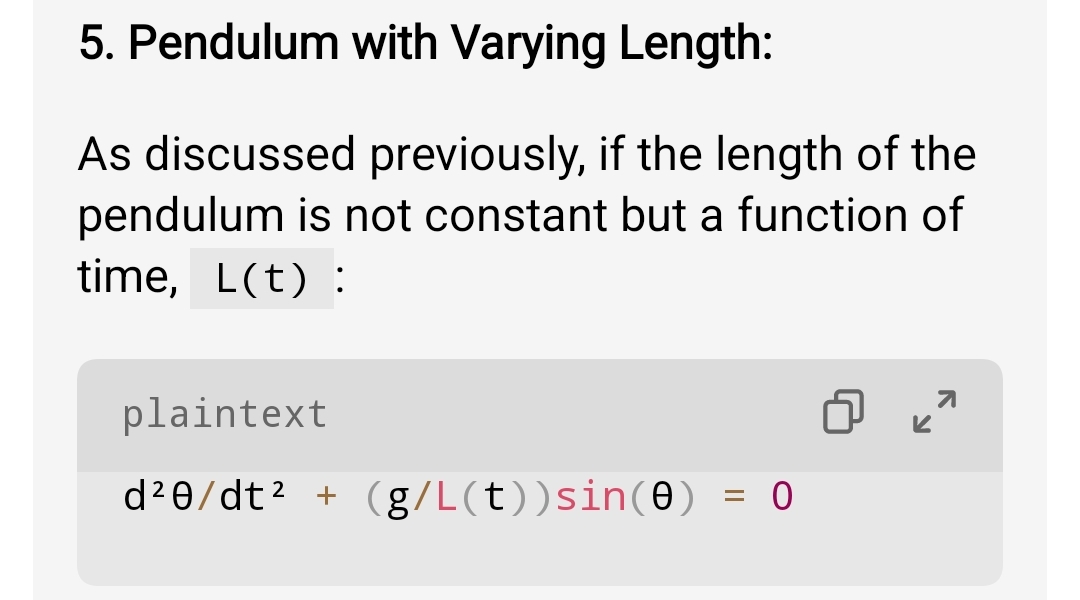❤️🧡💛💚💙💜❤️🧡💛💚

참고: 운동 방정식 검토
운동 방정식의 수학적 공식화는 모델링되는 시스템의 세부 사항에 크게 좌우됩니다. 단 하나의 "운동 방정식"은 없습니다. 그러나 복잡성이 증가하는 몇 가지 일반적인 형태를 제공할 수 있습니다.
1. 단순 조화 운동(SHM) - 작은 각도 근사:
이것은 가장 간단한 모델로, 작은 각 변위(θ << 1 라디안)에만 유효합니다.
plaintext
d²θ/dt² + (g/L)θ = 0
여기서:
- θ 는 평형으로부터의 각 변위입니다.
- t 는 시간입니다.
- g 는 중력으로 인한 가속도입니다.
- L 은 진자의 길이입니다.
이것은 2차 선형 미분 방정식이며, 그 솔루션은 단순 조화 운동을 나타내는 사인 함수입니다.
2. 진자 방정식 - 큰 각도:
큰 각도의 경우, 소각 근사(sin θ ≈ θ)는 더 이상 유효하지 않습니다. 방정식은 다음과 같습니다.
plaintext
d²θ/dt² + (g/L)sin(θ) = 0
이것은 비선형 미분 방정식이며, 그 해는 간단한 사인 함수가 아닙니다. 이를 풀기 위해서는 보다 진보된 기술, 종종 수치적 방법이 필요합니다.
3. 감쇠 진자:
감쇠(공기 저항 또는 마찰로 인한)를 추가하면 감쇠 항이 도입됩니다.
plaintext
d²θ/dt² + b(dθ/dt) + (g/L)sin(θ) = 0
여기서 b는 감쇠 계수입니다. 감쇠 항은 각속도(dθ/dt)에 비례합니다.
4. 구동 진자:
외부 구동력 F(t) 추가:
plaintext
d²θ/dt² + b(dθ/dt) + (g/L)sin(θ) = F(t)
여기서 F(t)는 시간에 따라 달라지는 외부 힘을 설명하는 함수입니다.
5. 길이가 변하는 진자:
이전에 논의했듯이 진자의 길이가 일정하지 않고 시간의 함수인 경우 L(t):
plaintext
d²θ/dt² + (g/L(t))sin(θ) = 0
이것은 매개변수 구동 시스템이며 그 동작은 훨씬 더 복잡할 수 있습니다.
이러한 방정식은 진자의 운동을 모델링하는 데 있어 다양한 수준의 복잡성을 나타냅니다. 사용할 적절한 방정식은 특정 조건과 원하는 수준의 정확도에 따라 달라집니다. d²θ/dt²는 시간에 대한 θ의 2차 도함수(각가속도)를 나타냅니다. dθ/dt는 1차 도함수(각속도)입니다.
❤️ 🤍 💟 🧡 🤎 ♥️ ❤️ 🤍 💟 🧡
❤️🧡💛💚💙💜❤️🧡💛💚
Note: Review of kinetic equations
The mathematical formulation of the equation of motion depends heavily on the specifics of the system being modeled. There isn't one single "equation of motion." However, I can provide several common forms, progressing in complexity:
1. Simple Harmonic Motion (SHM) - Small Angle Approximation:
This is the simplest model, valid only for small angular displacements (θ << 1 radian):
plaintext
d²θ/dt² + (g/L)θ = 0
Where:
- θ is the angular displacement from equilibrium.
- t is time.
- g is the acceleration due to gravity.
- L is the length of the pendulum.
This is a second-order linear differential equation, and its solution is a sinusoidal function representing simple harmonic motion.
2. Pendulum Equation - Large Angles:
For larger angles, the small-angle approximation (sin θ ≈ θ) is no longer valid. The equation becomes:
plaintext
d²θ/dt² + (g/L)sin(θ) = 0
This is a nonlinear differential equation, and its solution is not a simple sinusoidal function. It requires more advanced techniques to solve, often numerical methods.
3. Damped Pendulum:
Adding damping (due to air resistance or friction) introduces a damping term:
plaintext
d²θ/dt² + b(dθ/dt) + (g/L)sin(θ) = 0
Where b is the damping coefficient. The damping term is proportional to the angular velocity ( dθ/dt ).
4. Driven Pendulum:
Adding an external driving force F(t) :
plaintext
d²θ/dt² + b(dθ/dt) + (g/L)sin(θ) = F(t)
Where F(t) is a function describing the time-dependent external force.
5. Pendulum with Varying Length:
As discussed previously, if the length of the pendulum is not constant but a function of time, L(t) :
plaintext
d²θ/dt² + (g/L(t))sin(θ) = 0
This is a parametrically driven system, and its behavior can be significantly more complex.
These equations represent different levels of complexity in modeling a pendulum's motion. The appropriate equation to use depends on the specific conditions and the desired level of accuracy. Remember that d²θ/dt² represents the second derivative of θ with respect to time (angular acceleration). dθ/dt is the first derivative (angular velocity).
❤️ 🤍 💟 🧡 🤎 ♥️ ❤️ 🤍 💟 🧡